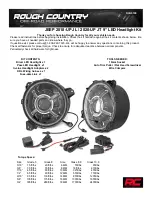
Technical features for driving comfort and safety
58
Manual operation
The LED above the button flashes in addition.
System limitations
PDC is no substitute for your personal
assessment of obstructions. The sensors
have certain dead areas in which objects cannot
be detected. In addition, the identification of
objects may not be possible if the physical lim-
its of the ultrasonic measuring principle are
exceeded, for instance with trailer noses and
hitches, and thin or wedge-shaped objects.
Low objects already indicated, such as a kerb,
may enter the sensors' dead areas before a
continuous audible signal is given. Higher, pro-
truding objects, such as ledges, may not be
detectable. Loud sound sources outside or
inside the car can drown out the PDC signal.
<
Keep the sensors clean and free from ice,
so that they always operate reliably.
When using a high-pressure cleaner, do not
spray the sensors for extended periods of time
and only from a distance of at least 10 cm
(4 in).
<
Driving stability control
systems
Your BMW has a number of systems that help
to maintain the vehicle's stability even in
adverse driving conditions.
ABS Anti-lock Brake System
ABS prevents the wheels from locking when
the brakes are applied. The car remains steera-
ble even under full braking. This increases
active safety.
ABS is ready to operate each time the engine is
started. Safe braking, see page
.
Electronic brake force distribution
The system regulates the braking pressure on
the rear wheels in order to stabilise the braking
behaviour.
Dynamic Brake Control DBC
If the brake pedal is pressed down rapidly, this
system automatically boosts the braking force
to a maximum and thus helps to keep the brak-
ing distance as short as possible when a full
brake application is made. It also makes full use
of the advantages offered by ABS.
Maintain pressure on the brake pedal during the
entire brake application. If the brake pedal is
released, DBC will be switched off.
Dynamic Stability Control DSC
DSC prevents the driving wheels from losing
traction when you pull away from rest or accel-
erate. DSC also recognises unstable driving
conditions, for example if the rear of the car is
about to swerve or if momentum is acting at an
angle past the front wheels. In these cases DSC
reduces engine output and applies the brakes
at individual wheels, helping, within the limits
imposed by the laws of physics, to keep the car
safely on course.
Not even DSC can overcome the laws of
physics. It is therefore the driver's
responsibility to adopt a suitable driving style in
every situation. Do not forgo the additional
safety afforded by this system by taking driving
risks.
<
Dynamic Traction Control DTC
DTC is a traction-optimised version of DSC
intended for use in special circumstances, such
as roads covered by deep snow. Under these
circumstances the system ensures maximum
forward traction, but at a certain cost in terms of
stability. Consequently, you must exercise suit-
able caution when driving under these condi-
tions.
In the following exceptional situations it may be
best to activate DTC for a short time:
>
When driving uphill on snow-covered roads,
in slush or on unploughed, snow-covered
roads
>
If the car has to be rocked out of or started in
deep snow or on a loose surface
>
If snow chains are fitted.
Online Edition for Part-No. 01 41 0 159 204 - © 03/05 BMW AG
Summary of Contents for 320d xDrive
Page 7: ...Online Edition for Part No 01 41 0 159 204 03 05 BMW AG...
Page 15: ...Online Edition for Part No 01 41 0 159 204 03 05 BMW AG...
Page 85: ...Online Edition for Part No 01 41 0 159 204 03 05 BMW AG...
Page 93: ...Online Edition for Part No 01 41 0 159 204 03 05 BMW AG...
Page 127: ...Online Edition for Part No 01 41 0 159 204 03 05 BMW AG...
Page 143: ...Online Edition for Part No 01 41 0 159 204 03 05 BMW AG...
















































